Mastering Wave Riding Techniques in Kiteboarding
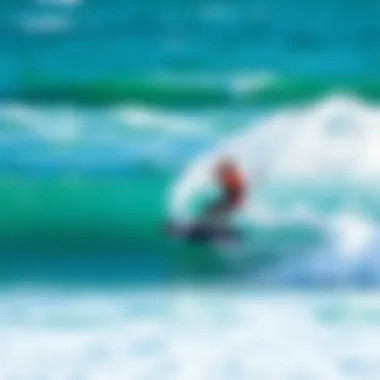
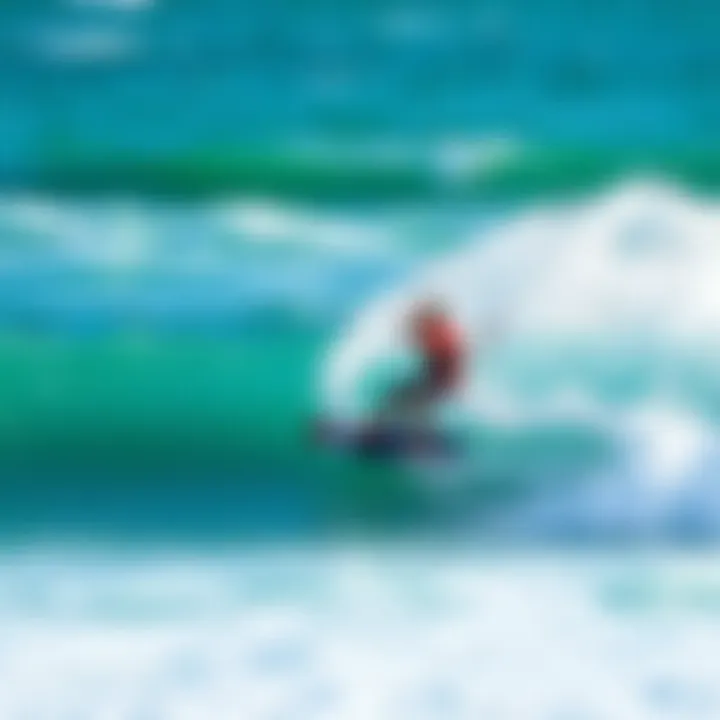
Intro
Kiteboarding, often described as a dance between the wind and the waves, encompasses not only the thrill of the ride but also a deep understanding of the ocean's dynamics. The challenge of conquering waves while harnessing the power of the wind is an exhilarating experience for riders of all levels. This guide will elucidate the nuances of wave riding in kiteboarding, bridging the gap between equipment selection, skill acquisition, and environmental awareness. For every kiteboarder, whether a newbie finding their footing or a seasoned pro searching for that perfect swell, mastering the art of wave riding is a journey filled with learning and adventure.
Gear Selection
Selecting the right gear is like choosing the brush and canvas for a masterpiece. It plays a crucial role in your wave riding experience, ensuring not only performance but also safety and comfort.
Types of Kites
When it comes to kites, different types cater to various wind conditions, skill levels, and riding styles. Understanding these differences is vital:
- All-Terrain Kites: These are versatile, suitable for light to moderate winds and ideal for both flatwater and wave riding. A classic example would be the North Rebels.
- Wave Kites: Designed for wave riding, these kites offer improved handling in stronger winds and can shift seamlessly between rapid turns. The Naish Pivot is a notable choice here.
- Freeride Kites: Perfect for those who like to mix it up, these provide a balance between ease of use and performance. Take a look at the Duotone Dice if you're heading this route.
Choosing the Right Board
The board is where the magic happens. A well-chosen board can enhance your wave riding tremendously. Here are key factors:
- Board Size and Shape: Shorter boards are generally better for waves, providing agility and responsiveness, while longer boards offer stability for beginners.
- Fin Configuration: Different fin setups affect how the board interacts with the water. A thruster setup is optimal for maneuverability in waves.
- Material Composition: Boards typically come in epoxy or polyurethane. Epoxy boards, while lighter, can be less durable than their polyurethane counterparts.
Selecting the right board entails balancing your personal preference, skill level, and the kind of waves you'll be riding. It’s worth spending time to test various shapes and sizes.
Skill Development
While the equipment is key, no kite is going to help you if you don't have the skills to control it.
Essential Techniques
Wave riding goes beyond simple kite control. Emphasis should be on:
- Timing Your Turns: It’s critical to time your turns with the wave’s peak, keeping the kite high to maintain speed and propulsion.
- Body Positioning: A low center of gravity allows for greater balance, which is essential for making those tight turns in the surf.
- Reading the Waves: Understanding how the wave breaks will give you the edge on where to position yourself for the best rides.
Progression Tips
Improving your skill set is a gradual process. Here are some strategies to enhance your technique:
- Practice Regularly: Consistency is key; the more time you spend on the water, the faster your progress.
- Film Your Sessions: Watching your rides can expose areas for improvement that you might not notice in the moment.
- Seek Feedback: Getting insights from instructors or peers can provide valuable perspectives on your technique.
- Join Local Groups: Engaging with fellow kiteboarders can increase your skill set and motivate you to push your limits.
The ocean is not just a playground; it's a teacher. Every wave offers a lesson, every ride a new insight.
Understanding Wave Dynamics
In the realm of kiteboarding, comprehending wave dynamics is crucial. It significantly influences how riders interact with the sea, ultimately determining their overall experience and performance. The ocean is ever-changing, with waves acting as nature's canvas for kiteboarders. Understanding how waves are formed, the types of waves encountered, and the energy they carry can be the difference between riding successfully and struggling to keep afloat.
Being aware of wave dynamics helps riders anticipate their movements, allowing them to navigate effectively. A solid grasp of the science behind waves equips enthusiasts with practical knowledge to make informed decisions regarding their riding technique, gear selections, and safety measures. Moreover, understanding these dynamics enables riders to adjust their approaches according to varying wind conditions and water environments.
The Formation of Waves
Waves are born from the wind. When wind blows across the surface of the ocean, it creates turbulence that disturbs the water. As this force acts upon the water surface, it generates ripples. As these ripples interact, they combine to form larger waves. The size and energy of these waves depend on several factors, including wind speed, duration, and the distance over which the wind blows, also known as fetch.
Additionally, local geography, such as sandbars or coral reefs, influences wave formation. These features can amplify or transform incoming swells, creating conditions that vary from mellow to bone-rattling rides. Understanding the formation process empowers kiteboarders to better predict wave behavior, making it easier to time jumps or rides within the perfect swell.
Types of Waves
A kiteboarder's experience hinges significantly on the types of waves encountered. Each type has its distinct characteristics and challenges.
Ocean Swells
Ocean swells emerge from distant storms and travel vast distances across the sea, making them one of the most desirable wave types for kiteboarding. What sets ocean swells apart is their smooth and powerful nature. The consistent, rolling shape of these waves allows for an exhilarating ride.
- Characteristics: Typically larger and more rounded compared to other wave types.
- Benefits: Their predictability and energy make them ideal for various riding techniques, from carving turns to launching jumps. Kiteboarders often seek out these swells for long rides and maneuvers that demonstrate skill and style.
- Downside: They can also be intimidating for novice riders due to their size and the power associated with them.
Choppy Waters
Choppy waters are common in windy conditions, where the surface appears disjointed. The irregularity of these water conditions can be frustrating but also presents an opportunity for skill enhancement. Riding in chop forces you to develop dexterity and adjust your technique on the fly.
- Characteristics: Short, playful waves that can create jarring and unpredictable movements.
- Benefits: This scenario can be advantageous for practicing quick turns and maintaining balance.
- Downside: Choppy waters can lead to exhausting rides, as they require constant adjustments and can result in fatigue or crashes if not properly managed.
Wind Waves
Wind waves, as their name implies, are generated by local winds. Unlike ocean swells, they tend to be smaller and sharper, tossing riders around unpredictably. These waves can catch kiteboarders by surprise, due to their sudden appearance and fleeting nature.
- Characteristics: Generally shorter and steeper than swells.
- Benefits: For some, wind waves offer a thrilling experience, allowing for spontaneous jumps and tight turns. However, they can also serve as a confidence builder for those mastering the art of riding.
- Downside: The erratic nature may not be ideal for everyone and can lead to frustrating moments.
Wave Energy and Movement
Understanding wave energy is essential for riding waves effectively. Energy in a wave can be classified into kinetic and potential energy. Kinetic energy is associated with the wave's mass and speed, while potential energy relates to its height. Knowledge of this dynamic allows riders to harness the wave's power for their advantage.
When approaching waves, understanding their movement—whether they are breaking or reforming—helps kiteboarders anticipate how to ride them. Strategizing based on wave behavior can lead to superior performance, a favorable ride, and a more engaging connection with the ocean.
The Mechanics of Wave Riding
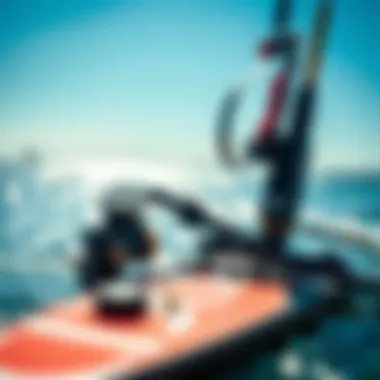
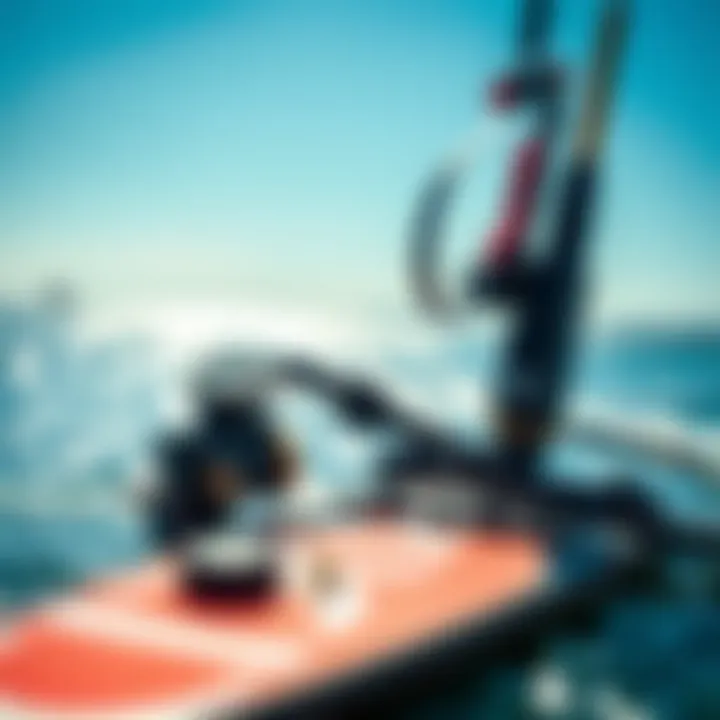
Understanding the mechanics of wave riding is vital for any kiteboarder aspiring to master the waves. It's not just about catching air and gliding over the water; it involves a nuanced engagement with the elements at play. The technique you employ while riding waves can significantly accentuate your performance and overall enjoyment.
Choosing the Right Technique
When it comes to wave riding, the technique you select can make all the difference. Here, we delve into three popular methodologies.
Edge Control
Edge control refers to how effectively a rider utilizes the board's edge to carve through the water. This technique is crucial because it affects speed and direction. By applying pressure on the heel or toe edge, the kiteboarder can generate a sharper turn, harnessing more energy from the wave. This is a beneficial choice as it allows for precision in navigating the wave's contours.
Moreover, edge control can enhance stability, especially in larger swells, making it a key characteristic for riders who desire smooth transitions. It's important to note that while effective, improper edge control could lead to wipeouts, particularly in choppy conditions.
Bodysurfing
Bodysurfing takes the experience down to its core, allowing riders to interact intimately with the ocean's swell. This technique strips away the complexities of gear, letting the rider utilize their body to catch waves. A key characteristic of bodysurfing is its accessibility; no special equipment is needed beyond a surfboard or even just the body itself. It's a popular choice among those who appreciate the raw connection with nature.
However, while bodysurfing provides a unique fullness of experience, it does carry risks, especially when engaging in challenging wave conditions. It's vital for riders to be aware of their limitations and the environment to avoid dangerous situations.
Jumping Technique
Jumping technique is an exhilarating aspect of wave riding, which allows riders to soar above the wave's surface. The key characteristic here is the powerful lift generated by the kite in conjunction with the wave. Not only does this technique showcase the rider's skills, but it is also a thrilling way to capitalize on the surf's energy.
That said, jumping can be tricky. Riders face the unique challenge of timing their jumps perfectly to the wave's rhythm. If executed improperly, crashes can cause serious injury. Hence, it's important for riders to practice this technique with caution, ideally in suitable conditions.
Adjusting to Conditions
To fully enjoy wave riding, one must learn to adapt to the conditions at hand. Here, we explore three major factors.
Wind Direction
Wind direction plays a massive role in wave riding conditions. It defines how the kite behaves as well as how the waves form. A key characteristic of wind direction is its ability to influence the size and power of incoming swells. For example, an onshore wind typically flattens the waves, making it easier to ride, while an offshore wind may lead to sharper, steeper waves.
Adjusting to wind direction is essential; knowing when to take advantage of optimal wind conditions can greatly enhance the joy of riding. However, a sudden shift can also cause complications. Riders should remain vigilant and adaptable to changing winds.
Tide Changes
Tide changes introduce a dynamic aspect to wave riding that requires attention. As tides rise and fall, they shift the currents and the shape of the waves. Understanding the tide is crucial for maximizing riding quality. For instance, riding during a mid to high tide often yields cleaner conditions, while low tides can expose hazards like reefs and rocks.
Riders should familiarize themselves with local tide charts, as ignoring this factor can mean trouble. Ensuring that you’re aware of tide changes can elevate your experience significantly.
Local Knowledge
Local knowledge is an invaluable resource for successful wave riding. Each location has its quirks, such as specific wave patterns, hidden hazards, or even particular wind conditions. The key characteristic of relying on local knowledge is tapping into the insights of seasoned riders who understand the subtleties of their surroundings. They might tell you where to find the best waves or warn you about any unpredictable currents.
Being part of a local riding community can enrich your skills and safety. However, it's essential to recognize that local spots might be seasonal or have rules of engagement. Respecting their traditions and understanding the culture can go a long way in enhancing your wave riding experience.
"The ocean has its own rhythm. Knowing how to ride it comes from understanding the subtle dance between the wind, tide, and the waves."
By focusing on these mechanics of wave riding, kiteboarders can refine their skills and better engage with the vast playground of the sea. Whether you prefer edge control, bodysurfing, or jumping, understanding the impact of wind direction, tide changes, and local knowledge can significantly enhance your riding experience.
Essential Gear for Wave Riding
In the realm of kiteboarding, particularly when it comes to wave riding, the right equipment can be the difference between an exhilarating experience and a frustrating one. Proper gear is not just about enhancing performance; it's also about safety and comfort. Choosing the right gear tailored to the specific conditions can significantly improve your control and enjoyment on the water.
Kite Selection
Selecting the right kite is foundational for any rider looking to harness the power of waves. A kite designed for wave riding needs to respond swiftly to varying conditions.
Size Considerations
The size of your kite can drastically affect your performance. A larger kite will catch more wind, which can be advantageous in light winds, allowing you to ride more effectively. However, if the winds are strong, a smaller kite is generally more manageable.
A good rule of thumb is to go for a kite that balances well with your weight, skill level, and the wind conditions. Overlooked, this can turn your fun day out into a struggle. If you're a beginner, starting with a kite in the mid-range of your size options lets you build confidence without overwhelming yourself with power.
Key characteristic: Opting for the right size ensures that riders can efficiently use their strength and technique without being overpowered by the wind.
Unique feature: The ability to adapt kite size to changing wind conditions allows for versatility in riding.
Shape Variations
Kite shapes play a crucial role in maneuverability and response time. Wave-specific kites often feature a delta shape or a fuller leading edge, which enhances stability and offers a smooth ride through turbulent water. This shape allows riders to harness the wave's power without getting tossed around.
Key characteristic: A well-shaped kite will maintain lift and control even in choppy conditions, proving to be a worthy ally on the waves.
Unique feature: The delta design, typically more forgiving in turbulent conditions, promotes easier retries after falls, making it a great choice for all skill levels.
Material Effects
The materials used in kite construction can’t go unnoticed. High-quality fabrics and reinforcements lead to improved performance and durability, which are vital when meeting the forces of waves. The lightweight and strong materials help maintain responsiveness and speed while also resisting wear and tear from saltwater and UV damage.
Key characteristic: Lighter materials allow for quicker turns and a better performance overall.
Unique feature: Choosing a kite built with durable materials means less downtime and more time riding.
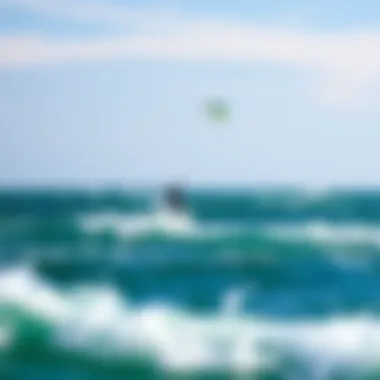
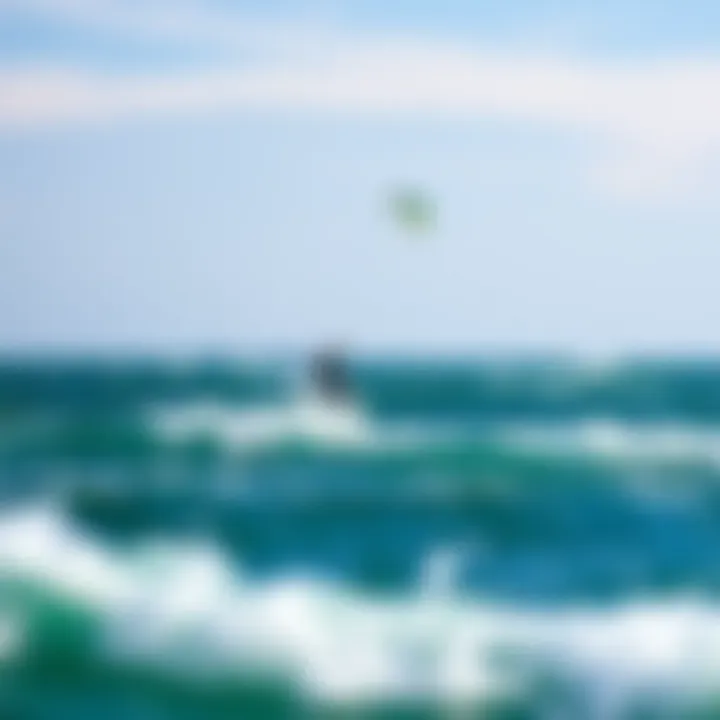
Board Types
The board is just as crucial as the kite. It can dictate how well a rider can carve through waves or execute jumps. Choosing between board types often comes down to personal style and the types of conditions.
Directional Boards
Directional boards are often favored for wave riding due to their shape, which resembles a surfboard. These boards offer more grip while riding down the line and enhance the overall wave-riding experience.
Key characteristic: Their streamlined design allows for sharper turns and smoother rides on the face of the wave.
Unique feature: Directional boards excel in down-the-line riding, which is key for anyone aiming to maximize their wave riding skills.
Twintip Boards
Twintip boards, while popular for freestyle, are also suitable for wave riding under certain conditions. They allow for easier transitions and can perform well in choppy waters where directional boards might struggle.
Key characteristic: The symmetry of twintip boards makes them incredibly versatile for switching stances.
Unique feature: Riders who might be on the fence about committing to directional boards can use twintips effectively even in moderate wave conditions.
Custom Options
Custom boards are becoming increasingly popular. They allow riders to tailor their equipment to their specific needs and preferences. Conversations with skilled shapers can lead to designs that match a rider's style, weight, and the usual conditions they tackle.
Key characteristic: Custom boards can enhance performance capabilities uniquely suited to an individual rider.
Unique feature: They can integrate specific design elements to improve performance in specific conditions—whether that is increasing speed for flat water or enhancing maneuverability in wave settings.
Safety Equipment
Safety should be a top priority when engaging in wave riding. The unpredictable nature of the ocean means that having the right safety gear can prevent mishaps.
Impact Vests
Impact vests are essential for cushioning impacts during wipeouts. They add a layer of safety, protecting your body from the hard surface of the water or your board.
Key characteristic: These vests are typically designed to be lightweight while providing necessary buoyancy.
Unique feature: Well-designed impact vests can help riders feel secure, allowing them to focus more on riding rather than worrying about injuries.
Helmets
Wearing a helmet is becoming more common in kiteboarding, particularly for those tackling waves. Helmets protect your head during spills and crashes, particularly in rough conditions.
Key characteristic: They help to withstand strong impacts with either the water or equipment.
Unique feature: Many helmets now integrate a snug fit and lightweight designs to ensure comfort without compromising safety.
Leashes
Leashes are vital for ensuring you remain attached to your board in dramatic wipeouts. A good leash can prevent the board from flying away and potentially injuring someone else.
Key characteristic: A reliable leash ensures your board stays within reach, minimizing the risk of loss.
Unique feature: Leashes come in different lengths and materials, allowing riders to choose an option that balances comfort and security.
Remember that in kiteboarding, proper gear not only enhances performance but contributes significantly to your safety and enjoyment as well.
Environmental Awareness in Wave Riding
Understanding the environmental impact of wave riding is crucial for kiteboarders. With the sport's growing popularity, it becomes increasingly important to protect the ecosystems we enjoy. Engaging with nature responsibly ensures that these wave-riding experiences remain available for future generations while fostering a sense of stewardship among kiteboarding communities.
Protecting Marine Ecosystems
Marine ecosystems are delicate and complex. Each time a kiteboarder cuts through the waves, they interact with surroundings that host a variety of life forms. Recognizing the impact of our sports activities on these ecosystems is essential. From coral reefs to mangroves, our favorite riding spots may harbor species that are sensitive to disturbance.
Preservation can take the form of adhering to designated riding zones or educating oneself about local habitats. For instance, avoiding areas that are known breeding grounds for fish or nesting sites for seabirds can minimize disruption. Simple choices can help maintain the health of the ocean and ensure we ride in harmony with nature as opposed to against it.
Responsible Riding Habits
Awareness of Local Wildlife
Before hitting the waves, knowing what’s around is vital. Each region has its own unique wildlife, and kiteboarders should respect their habitats. Many locations may host endangered species like sea turtles or seals, which can be affected by noise or human presence. This awareness contributes to a nurturing environment for these creatures, ensuring a balance between adventure and preservation.
Furthermore, observing wildlife can enhance the riding experience. Imagine gliding alongside a pod of dolphins or catching a glimpse of a majestic eagle soaring overhead. Those moments are part of nature’s beauty and underline the significance of being considerate adventurers on the water.
Environmental Regulations
Local environmental regulations should not be viewed merely as restrictions but as guidelines for sustainable coexistence. Many areas have specific rules in place to protect sensitive habitats. Understanding and complying with these regulations helps to maintain the integrity of coastal areas. For instance, some beaches might restrict activity during certain seasons to protect nesting animals.
Following these regulations ensures that kiteboarding remains sustainable long-term, benefiting both the sport and the environment. A compliant rider is one who recognizes their role in the ecosystem, creating a positive feedback loop between recreation and conservation.
Minimal Footprint Approach
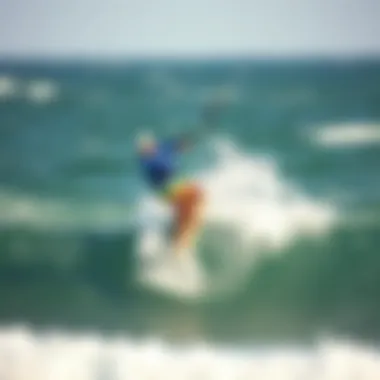
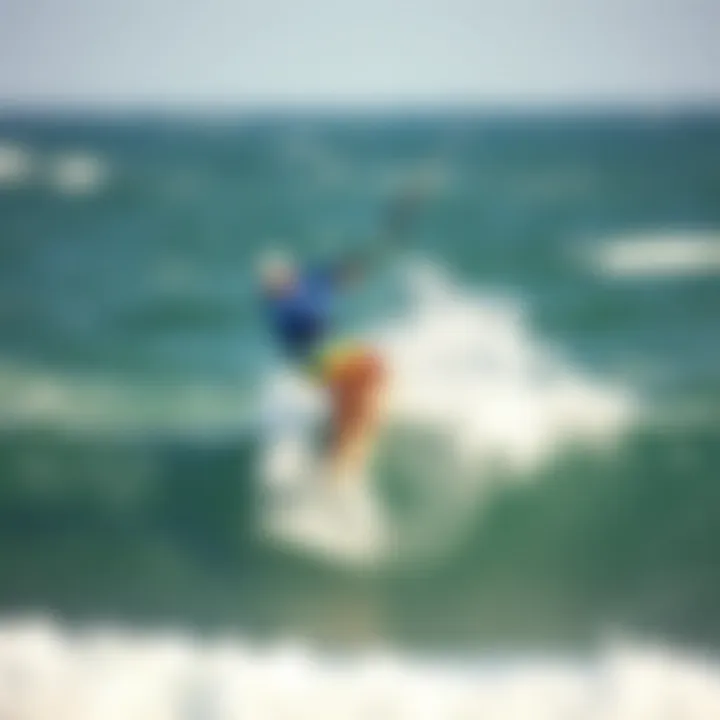
The minimal footprint approach emphasizes reducing one’s impact on the environment. Kiteboarders can implement this by using eco-friendly gear and minimizing waste while on the water. Bringing reusable water bottles, disposing of trash properly, and being conscious of equipment damage can help maintain the beauty of riding spots. Each small action adds up.
On a broader scale, supporters of this approach often advocate for community clean-up days or participate in local conservation efforts. By collaborating with organizations or local communities, riders can give back while enjoying their passion, enhancing both their experience and the health of the environment.
Protecting the environment isn’t just an obligation—it's a chance to participate in a larger community effort to keep our oceans beautiful for generations to come.
By actively engaging in environmental awareness, kiteboarders can contribute to a vibrant ecosystem while enjoying all the thrills that wave riding has to offer. Each day on the water not only becomes an adventure but also a step toward sustaining the spaces we cherish.
Kiteboard Destinations for Wave Riding
When it comes to kiteboarding in waves, the location can make or break your experience. A kiteboard destination offers not just the thrill of riding but also the unique challenges and rewards provided by local wave conditions. Knowing where to go is crucial, as different places have different characteristics that can enhance or complicate your riding experience. The right spot can be a playground, while the wrong one can lead to frustration or worse.
Global Hotspots
Canary Islands
The Canary Islands are often the first destination that comes to mind for kiteboarders. This archipelago off the northwest coast of Africa serves up consistent wind and diverse wave conditions, making it ideal for all skill levels. The consistent trade winds can help you ride from sunrise to sunset.
One of the standout features of the Canary Islands is the variety of spots you can choose from. For example, Fuerteventura is famous for its flat water and powerful waves, attracting both beginners and advanced riders. However, the strong currents can be a double-edged sword; it’s crucial to be aware and prepared.
The sandy beaches and clear waters make launching and landing a breeze, but with increasing popularity, it’s vital to stay updated on local rules and etiquette. Local kite schools often offer advice and safety briefings for those unfamiliar with the terrain.
North Shore of Oahu
The North Shore of Oahu is another coveted spot among enthusiasts. Known for its legendary waves, this destination offers challenging conditions that can excite even the most seasoned kiteboarders. The waves here vary greatly; from wind-driven chop to massive swells that rival some of the world’s best surf spots, it’s a location that demands respect.
What makes the North Shore truly unique is its community. The local riders are always ready to share tips and knowledge, creating a welcoming atmosphere for those who heed the local customs. However, this is not a beginner-friendly location, and caution is advised due to strong currents and the intimidating size of the waves during winter months. Always remember that safety should be your top priority.
Margaret River
Margaret River in Australia is often overshadowed by its more famous counterparts but is a gem on its own. Renowned for its stunning coastline and the quality of its waves, this location is gaining traction among kiteboarders. The region hosts numerous spots that are less crowded, allowing for a more intimate riding experience.
The area’s unique topography leads to waves that are often both fast and powerful, which can be exhilarating. This region tends to have variable wind conditions, giving riders opportunities for different techniques. You may find flat water paired with small waves in one spot and bigger swells nearby.
However, Margaret River does come with its own set of challenges. The water can get cold, so having the right wetsuit is essential. Furthermore, the coastline is rugged, with rocky bits and tidal influences that can catch you off-guard if you’re not careful.
Emerging Locations
In addition to the hotspots, there are various emerging locations where kiteboarding is rapidly gaining popularity. Cape Verde is one such spot, valued for its steady winds and diverse wave options, making it a new favorite among travelers. Similarly, Sri Lanka offers beautiful beaches and inviting waters, though riders should be cautious of local regulations and wildlife.
Each of these lesser-known locations offers unique experiences that can enhance your understanding and love for wave riding. As kiteboarding continues to grow in popularity, many new and exciting spots will undoubtedly emerge, offering even more opportunities for riders looking to push their limits.
The Future of Wave Riding in Kiteboarding
As the popularity of kiteboarding continues to surge, understanding the future of wave riding becomes essential for avid kiters. This aspect not only encompasses the ongoing innovations in technology, but also addresses the shifting environmental factors that riders must adapt to. As conditions evolve, so does the need for riders to innovate technique and equipment, ensuring they remain savvy and capable in the face of new challenges.
Technological Advancements
New developments in kiteboarding technology play a pivotal role in enhancing the wave riding experience. Innovations in materials and designs have led to lighter and stronger kites, enabling greater control and responsiveness on the water. For instance, the integration of advanced materials like Dyneema in kite lines has improved strength-to-weight ratios significantly. This means less drag in the air, allowing riders to gain speed quicker, which is essential for catching those elusive waves.
Moreover, advancements in board technology are noteworthy. Directional boards have seen a transformation, featuring concave shapes and new fin placements that allow for better grip and maneuverability as riders navigate the ever-changing wave landscape. The advent of smart technology in kites, which includes features like GPS tracking and performance analytics, offers the potential to optimize a rider's skill set by providing real-time feedback for improvement.
- Innovation in materials: Dyneema for strength, lighter kites.
- Board improvements: Concave designs, better grip.
- Smart technology: GPS tracking and performance analytics.
As brands continue to push the envelope, riders will have access to gear that not only enhances performance but also aligns with more environmentally sustainable practices. Gear that invests in eco-friendly materials and production methods will more likely dominate the market, appealing to a growing demographic of socially conscious riders.
"Embracing innovation isn't just about staying ahead; it's about preserving the sport for future generations."
Changing Environmental Conditions
The environment isn't static; it’s influenced by climate change, pollution, and human activity. Riders need to recognize how these factors may alter conditions on the water. Increased instances of unpredictable weather patterns can make for challenging but exhilarating conditions. However, this also calls for more awareness regarding safety and adaptability.
Understanding oceanic currents, seasonal wind patterns, and the biological implications of climate shifts is critical for any kiteboarder looking to ride the perfect wave. Local knowledge becomes indispensable – knowing how your favorite spot behaves throughout the year is like having a cheat sheet before a big exam. As beaches and coastlines evolve due to rising sea levels or erosion, it’s sensible for riders to monitor these changes.
Furthermore, as more kiters take to the waves, the responsibility to protect marine ecosystems becomes paramount. Riders should be aware of their impact on local wildlife, maintaining a respectful distance from marine life and advocating for sustainable practices in their communities.
- Adaptation to weather patterns: Understanding increasing unpredictability.
- Local knowledge: Essential for riding spots.
- Protecting ecosystems: Advocacy and responsible riding; respect for marine life.
As wave riding in kiteboarding evolves, being mindful of both technological innovations and environmental conditions ensures that the sport remains enjoyable and sustainable for all enthusiasts. Indeed, the future of this exhilarating sport hinges on our ability to adapt and innovate while honoring the natural world around us.
Community and Culture in Wave Riding
When it comes to kiteboarding, especially in wave riding, the community aspect is often just as vital as the technical skills you develop. Individuals who engage in kiteboarding share a unique bond, forged through adrenaline-laden experiences and a mutual appreciation for the ocean's complexities. The culture surrounding wave riding not only enhances personal enjoyment but also fosters respect for the sport and its environment.
Connecting with Other Riders
Interactions with fellow riders can prove invaluable in your kiteboarding journey. Here’s why:
- Shared Knowledge: Whether it's a seasoned kiteboarder showing you the ropes or a newcomer eager to learn, exchanging tips and tricks can significantly sharpen your skills. Understanding local spots from those who ride there regularly can provide insights on wind patterns and hidden hazards.
- Camaraderie: Kiteboarding can sometimes feel isolating, especially if you’re hitting the waves solo. By connecting with others, you create a network that can boost motivation and make each session more enjoyable. Plus, sharing your achievements or learning experiences can forge friendships that last beyond the water.
- Safety in Numbers: Riding in a group can lead to safer sessions. Not only do you have eyes on you when things go awry, but experienced riders can also step in with guidance and support during tricky conditions.
Connecting with others can happen through social media platforms like Facebook, or Reddit, where kiteboarders often share their experiences, form ride groups, and organize meet-ups. Beyond online platforms, local shops or cafes near kiteboarding spots frequently host events that bring riders together.
Events and Competitions
Dive into the wave riding community by participating in events and competitions. These gatherings serve multiple purposes:
- Skill Development: Competing against others, whether in a formal competition or a local gathering, can push your boundaries. You’ll quickly find your weaknesses and strengths when watched by your peers. Moreover, you often learn by observing the techniques of other competitors.
- Building Relationships: Events provide perfect backdrops for meeting other wave riders and strengthening existing bonds. The shared thrill of competition and collective experiences can create lasting memories.
- Celebration of Culture: Competitions often highlight regional diversity in kiteboarding techniques and styles. Events like the King of the Air in South Africa or the Red Bull Kite Surfing events not only showcase skills but also celebrate the unique knots of cultures that come together as people gather from all corners of the globe.
Join events organized by local clubs or larger organizations like the International Kiteboarding Association (IKA) to immerse yourself in the culture. These competitions attract not just open-minded riders but also influential personalities in the kiteboarding community, adding depth to your understanding of the sport.















